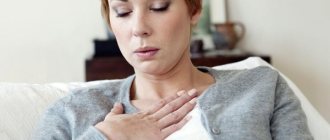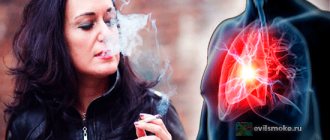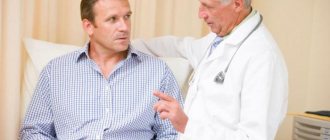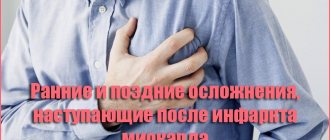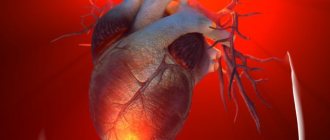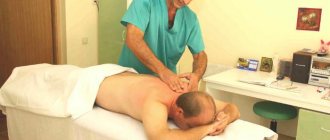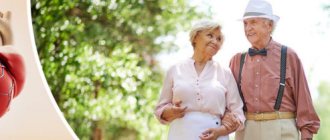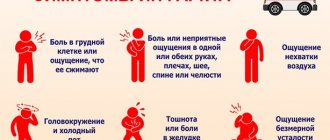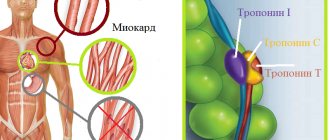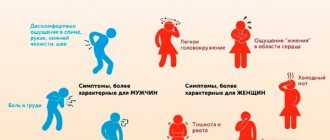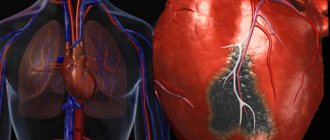- The need for massage after myocardial infarction
- When should you start massage?
- General massage rules
- Technicians
- Contraindications
In case of myocardial infarction, it is necessary to stimulate blood circulation, increase the overall tone of the body, and accelerate the patient’s adaptation. To achieve these goals, comprehensive measures are used, including massage. Its implementation involves various techniques, each of which has its own characteristics.
The need for massage after myocardial infarction
Massage is an important part of the rehabilitation program after myocardial infarction. It is used for certain indications, including:
- convalescence phase (the final stage of the disease);
- coronary insufficiency (I, II degree);
- post-infarction cardiosclerosis accompanied by hypertension;
- acute heart attack with a hypodynamic type of blood circulation;
- satisfactory general condition.
In addition to a specialized approach, it is useful for the patient to master self-massage. It is enough to perform it for two minutes and repeat several times a day. You can massage your neck, head, arms and stomach yourself.
After a heart attack, painful lumps affecting the connective tissue and subcutaneous tissue are often observed. During the massage, be sure to monitor the dynamics of the condition of these areas. Correctly chosen and implemented technique gradually reduces pain.
Massage after myocardial infarction provides a complex effect on the body, guaranteeing the following effects:
- the intensity of the pain syndrome decreases;
- the work of the heart muscle is facilitated;
- the lumen of the coronary vessels increases and the risk of stagnation in them decreases;
- blood circulation in peripheral tissues is stimulated.
Performing a massage reduces the load on the heart muscle due to stimulated blood circulation. Blood flows to the area being treated, causing the formation of new capillaries. At the same time, the volume of the vascular bed increases, against the background of which a decrease in blood pressure occurs.
The procedure involves relaxing the body. This is important for improving the patient’s mood and combating depression, which often occurs against the background of an illness. Massage after a heart attack is also necessary to prepare the cardiovascular system for upcoming physical activity.
Indications for use
Massage after myocardial infarction is prescribed for the following indications:
When prescribing a course of massage, doctors pursue a specific goal, which is as follows:
- reducing the intensity of pain;
- increase in the lumen of coronary vessels;
- reducing the risk of stagnation in the coronary vessels;
- facilitating the work of the heart muscle;
- stimulation of blood circulation in peripheral tissues;
- the starting stage before physical stress on the cardiovascular system.
General massage rules
Massage after myocardial infarction should be carried out exclusively by a specialist in this field with the appropriate qualifications. It is permissible to begin such a rehabilitation measure only with the permission of the attending physician.
After a heart attack, massage is performed according to certain rules. The following nuances must be observed:
- You can start massage only after the patient’s condition has stabilized.
- Gradually introduce different physiotherapeutic methods. Massage is just one of them. You should not start two or more procedures at once on the same day, since if you have a negative reaction to one of them, it will be more difficult to determine the cause.
- Start the massage gradually. They usually start with the lower extremities, performing only stroking. The remaining movements are added one by one, observing the patient’s reaction to them.
- At the initial stages, the massage is performed exclusively in a supine position. You can change it only when switching to free mode. When performing a massage in a lying position, the patient should be positioned so that the head of the massage is slightly raised.
- Monitoring the patient's condition. When adding new movements, it is necessary to monitor the patient's reaction to them. If it is negative, then the expansion of the technique should be delayed.
- Massage is recommended twice a day. The first session should only last a few minutes. The duration of sessions is increased gradually.
- A massage session always begins with checking the patient’s well-being. Monitoring of pulse, blood pressure, and respiratory rate is necessary. If any indicators change sharply in a negative direction, the procedure is stopped.
- When introduced into a rehabilitation program, therapeutic exercises are usually carried out 15 minutes after the massage session. At the same time, it is necessary to continue monitoring important indicators.
In addition to the general provisions, it is necessary to follow the individual recommendations of the attending physician. Each case is special, and therefore the approach to different patients may differ.
Indications for use
Massage is an integral method of comprehensive recovery after a heart attack. It is prescribed for specific indications:
- convalescence phase;
- insufficiency of coronary arteries 1 and 2 degrees;
- post-infarction cardiosclerosis, hypertension;
- acute infarction with hypodynamic blood circulation;
- general condition maintained at a satisfactory level.
In addition to therapeutic massage performed by a professional massage therapist, self-massage is also useful. It is enough to do it for a couple of minutes, repeating several times a day. It is permissible to massage the neck, head, stomach and arms on your own.
After a heart attack, painful lumps can form that affect the connective tissue, the fiber under the skin. In this regard, the dynamics of such compactions is monitored during the procedure. The correct technique helps to quickly eliminate pain.
Massage helps achieve the following results:
- reduce the manifestations of pain;
- improve myocardial function;
- the diameter of the lumen in the coronary vessels increases, the risks of congestion formation decrease;
- stimulation of blood flow in peripheral tissues.
The treatment significantly reduces the load on the myocardium by stimulating blood flow. Blood flows to the treated area, promoting the formation of new healthy capillaries. This increases the volume of the vascular bed, and blood pressure returns to normal.
Technicians
Massage as part of rehabilitation after a heart attack can be performed using various techniques. There are three main methods:
- in accordance with the patient's regimen;
- according to Dubrovsky;
- according to Biryukov and Belaya.
Each technique has its own distinctive features. The choice of the appropriate and most effective technique for a particular person should be made by a specialist.
Massage depending on the patient's regimen
This technique is focused on the stage of rehabilitation that a particular patient is currently going through. There are 4 rehabilitation modes:
- strict bed;
- light (extended) bedding;
- ward;
- free.
Massage is designed to provide a smooth transition from one stage to the next stage.
The most difficult stage for the patient is considered to be strict bed rest . Until the patient's condition is normalized, the use of any massage technique is prohibited.
After stabilization, the massage begins with stroking the limbs. It is important to maintain a slow, measured pace of movements. If the patient’s condition is satisfactory, then small joints are kneaded before the massage session. This eliminates blood stagnation in peripheral vessels. Massage is performed 2 times daily. The procedure should not last more than 5 minutes.
When switching to light bed rest, the massage technique begins to expand, gradually adding new elements. Actions should be gradual:
- First, continue stroking, adding rubbing movements to them.
- Then the rubbing is expanded. Rub your hands with four fingers, making spiral movements. To rub your feet you need 8 fingers. At first the limbs are pressed lightly, but gradually the intensity of the pressure is increased.
- At the end of light bed rest, add a light chest massage. It is performed with stroking and rubbing movements. You can massage the chest for no longer than 5 minutes. The total duration of the session can be up to 7 minutes.
When the patient switches to the ward mode, the massage technique expands significantly. The duration of the procedure can be increased to 10 minutes. The session involves the following actions:
- Adding kneading, felting and shaking to stroking and rubbing. Such actions are directed to the limbs.
- Five-minute chest massage. At this stage, alternating superficial and deep rubbing and stroking is indicated. The direction of the massage is important: it should coincide with the movement of the pectoralis major muscle.
- It is possible to massage the area from the left shoulder blade to the spine. At first, they limit themselves to light stroking and rubbing. Then sawing with the edges of the palms and the SPR-4 technique are added. These actions should take no more than 4 minutes.
When the patient switches to free mode , the massage can be performed in a sitting position. The session can last up to 15 minutes. Attention is focused on the collar area (upper back). Perform the massage with superficial and deep stroking movements, including circular ones. They also resort to rubbing, chopping and sawing movements, the SPR-4 technique.
The ability to perform certain actions provided for by massage is based on the patient’s condition. In some cases, the addition of new movements has to be postponed or elements of the massage technique must be adjusted.
Massage according to Dubrovsky
With this massage technique, oxygen inhalations are performed, that is, oxygen therapy. This combination stimulates blood circulation and simultaneously saturates the blood with oxygen.
The technique involves two main stages:
- First, the patient is given a massage, which lasts no more than 15 minutes.
- The second stage involves inhaling oxygen using a special mask.
Dubrovsky massage has a distinctive feature - the patient must be placed on the right side during the session. The session is based on massaging the back in this position. The specialist performs the necessary manipulations with his right hand, and holds the patient’s left hand with his left.
Massage equipment is selected individually. To do this, it is important to take into account the patient’s condition and perform an electrocardiogram.
Massage according to Dubrovsky is called segmental. The whole procedure takes place in 3 stages:
- The preparatory stage involves the use of classical massage techniques. It consists of stroking, rubbing and kneading the back muscles.
- The main stage involves massage using special techniques.
- The final stage is carried out similarly to the preparatory stage.
Massage according to Biryukov and Belaya
This technique is considered an alternative to the Dubrovsky technique. It can be used already in the first days after a heart attack.
The peculiarity of the massage is that it begins with the lower extremities. First, massage the gluteal region, gradually moving towards the feet.
They resort to the following movements:
- deep and superficial stroking with palms;
- squeeze-ups;
- felting;
- kneading with fingertips (4 or 8).
All movements are repeated 3-6 times alternately on both sides. The whole complex must be repeated. The required number of repetitions is based on the patient’s well-being and the recommendations given to him by doctors.
Further actions focus on the person’s perception of the massage. If tolerated well, the right arm is additionally massaged. In this case, the movements are similar to manipulations with the lower limbs.
If the massage provides a positive effect, and the patient’s well-being after the session does not change for the worse, then work with the back and gluteal region is allowed. To do this, the patient must lie on his side, bending his upper leg at the knee and hip joint. This position is necessary for stability.
Massage using this method is carried out for 3-5 minutes. Sessions are held daily or daily. The appropriate option is selected individually.
Basics of the technique
In the post-infarction state, massage is prescribed from the first days. The objectives of massage are to bring the patient out of a serious condition, restore blood and lymph circulation, and regulate metabolism.
The initial position of the patient during the procedure is lying on his back. The first massage sessions begin with the feet. The patient's leg is raised and lies on the upper third of the massage therapist's thigh. This position promotes natural blood flow and relaxation of the thigh muscles, which reduces the load on the heart.
The following techniques are performed on the thigh: longitudinal alternating stroking (4 - 6 times), longitudinal squeezing (3 - 5 times), stroking (3 - 5 times), double kneading (3 - 5 times), stroking (3 - 6 times) , felting (3 - 5 times). On the lower leg - longitudinal or combined stroking (6 - 8 times), any squeezing (3 - 5 times), kneading with the base of the palm, with the pads of four fingers (2 - 4 times), stroking (4 - 7 times).
Then the right hand is massaged. The massage is done in five positions. The patient lies on his back. On the shoulder, apply longitudinal straight stroking (3-4 times), longitudinal squeezing (2-3 times), ordinary kneading (2-3 times), stroking (4-6 times). The same goes for the forearm. Massage can be performed 2 times a day, daily or every other day. Session time: 5-7 minutes.
If the reaction is positive, after 5-7 sessions a massage of the back and buttocks is added. The patient's position is lying on the right side. The duration of the session increases to 10 minutes. Massage is provided daily.
Start the massage from the back. The patient lies on his right side, the lower leg is extended, the upper leg is bent at the hip and knee joints. This position gives stability to the pose. The massage begins on the right side of the back: stroking (3 - 6 times), squeezing (4 - 6 times), kneading with the base of the palm (3 - 5 times).
On the gluteal muscles, stroking (3 - 5 times), squeezing (3 - 7 times), kneading with the phalanges of the fingers bent into a fist and the base of the palm (3 - 7 times each) are carried out.
If the patient is allowed to sit or lie on his stomach, the duration of the first 5-7 sessions increases to 10-12 minutes, and if he feels well - up to 20 minutes.
The back massage begins on the right side with the patient lying on his stomach. Particular attention should be paid to the paravertebral zones (C3-C4, Dl-D8). Perform longitudinal alternating stroking (4 - 7 times), squeezing (4 - 6 times), kneading on long muscles with the base of the palms of both hands (4 - 7 times), phalanges of fingers bent into a fist (3-6 times), squeezing again (4-6 times) and stroking (5-7 times).
On the latissimus dorsi muscles, double circular kneading (4-6 times), with phalanges of fingers bent into a fist (3-6 times), and shaking (3-4 times) are used. The whole complex is repeated 2 - 6 times. Next, rubbing with the pads of four fingers on the intercostal spaces: straight, combined, dotted (2 - 4 times).
On the fascia of the trapezius muscle, rubbing with the pad of the thumb is straight, spiral (2 - 4 times), with the pads of four fingers (2 - 4 times). At the angle of the shoulder blade - rubbing with the edge of the palm (3 - 5 times). The whole complex is repeated 2 - 4 times. The same is done on the other side. Finish the back massage with longitudinal alternating stroking (4 - 7 times).
On the neck and trapezius muscles (on the left side the massage is longer) perform longitudinal alternating stroking (3 - 5 times), squeezing with the edge of the palm (3 - 5 times), ordinary kneading with the edge of the palm (2 - 5 times). Finish with stroking.
In the supine position, the massage begins on the left side of the chest: stroking (3 - 5 times), squeezing with the edge of the palm (3 - 6 times), double circular kneading (3 - 4 times), with the pad of the thumb (2 - 4 times), shaking (2 - 3 times), kneading with the base of the palm and the pads of four fingers (2 - 5 times each).
There are several specialized techniques for patients after a heart attack. The choice of method is made by the attending physician. Sometimes procedures are prescribed immediately after vital functions begin to stabilize.
In the first days after an attack, the massage is done for only 5–7 minutes, affecting only the lower limbs. As health and well-being normalize, the duration of one session can increase; the right arm is massaged, then the muscles of the back and buttocks are gradually involved.
Breast massage is acceptable provided that you start carefully - this is light stroking in the area of the chest muscles for 3 to 5 minutes. After the patient begins to sit down, the upper back and cervical-collar area are worked on. The duration of the session reaches 20 - 30 minutes.
Techniques and Techniques
Basic techniques:
- stroking;
- easy kneading;
- trituration.
Contraindications
Massage after myocardial infarction is very effective and important for subsequent rehabilitation, but not all patients are allowed. This direction is contraindicated in the presence of the following factors:
- aneurysms of the heart or aorta;
- cerebral atherosclerosis;
- acute fever;
- diseases of the abdominal organs accompanied by bleeding;
- tumors;
- pronounced varicose veins;
- thrombosis;
- acute myocardial ischemia;
- hypo- or hypertensive crisis;
- purulent process regardless of location;
- chronic osteomyelitis;
- tumors;
- pulmonary edema;
- pulmonary infarction;
- blood diseases.
Some contraindications are temporary. Massage can be started after the condition has normalized or after the acute period of the disease has ended.
Massage allows you to prepare the patient for further rehabilitation, which involves other physiotherapeutic techniques. It is important to follow the massage technique and choose the appropriate option in accordance with the doctor’s recommendations. During the course of massage and expanding its technique, it is important to monitor the patient’s condition and take into account his reaction.
Dispensary and polyclinic stage
At this stage, patients are individuals suffering from chronic ischemic heart disease with post-infarction cardiosclerosis. Main tasks of exercise therapy
: prevention of further development of atherosclerosis, secondary prevention of ischemic heart disease, the possibility of complete or partial withdrawal of medications, return to work. Exercise therapy is carried out in the form of long-term physical training (LPT). DFT is indicated when myocardial infarction is at least four months old in the gym using a group method or at home according to an individual program. Functional capabilities are determined using bicycle ergometry. They use therapeutic exercises, dosed walking, skiing, cycling, etc. throughout the patient’s life.
Massage for myocardial infarction
The timing of the start of massage is strictly individual. With a generally satisfactory condition, normal temperature and positive dynamics of clinical indicators, a suction massage of the legs, a light massage of the back (on the right side), and arms are used for 3 to 10 minutes daily. If the condition is satisfactory, there are no negative dynamics on the ECG and no severe complications (pulmonary edema and infarction, gastrointestinal bleeding), V. I. Dubrovsky recommends massage
from the first days of the disease in combination with
oxygen therapy
. Massage the back (in IP lying on the right side), using stroking, rubbing, shallow kneading, the abdomen, lower and upper limbs; the chest is stroked. The duration of the massage is 5-20 minutes, after which the patient breathes oxygen for 10-15 minutes. After discharge from the hospital, a general massage is performed in a sitting position with the head supported or lying down. Begin the massage from the back and collar area. When massaging the anterior chest wall, emphasis is placed on the left pectoral muscle and sternum. The duration of the procedure is 10-20 minutes (under the supervision of a doctor).
Read also: Silent myocardial infarction
